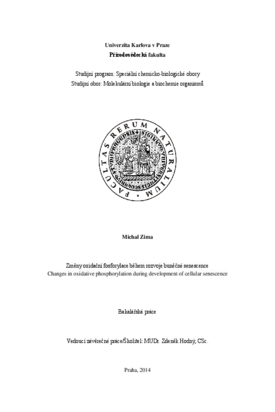Změny oxidační fosforylace během rozvoje buněčné senescence
Changes in oxidative phosphorylation during development of cellular senescence
bachelor thesis (DEFENDED)

View/
Permanent link
http://hdl.handle.net/20.500.11956/69272Identifiers
Study Information System: 143798
CU Caralogue: 990018566500106986
Collections
- Kvalifikační práce [20798]
Author
Advisor
Referee
Kašparová, Dita
Faculty / Institute
Faculty of Science
Discipline
Molecular Biology and Biochemistry of Organisms
Department
Department of Physiology
Date of defense
10. 9. 2014
Publisher
Univerzita Karlova, Přírodovědecká fakultaLanguage
Czech
Grade
Excellent
Keywords (Czech)
buněčná senescence, volné radikály kyslíku, cytokiny, mitochondrie, oxidačně fosforylační řetězec, NADPH oxidázyKeywords (English)
cellular senescence, reactive oxygen species, cytokines, mitochondria, oxidative phosphorylation chain, NADPH oxidasesBuněčná senescence představuje trvalé zastavení buněčného cyklu a je chápána jako aktivní odpověď buňky na nejrůznější vnitřní i vnější formy stresu, mezi které řadíme zejména poškození a ztrátu ochranných telomerických sekvencí, aktivaci některých onkogenů, poškození DNA a také účinky určitých cytokinů. Tato práce popisuje mechanismy, kterými buňky mohou dosáhnout senescentního fenotypu, a dává je do souvislosti se změnami oxidační fosforylace. Jsou také zmíněny vlastnosti senescentních buněk a důsledky jejich působení na své okolí. Zvláštní pozornost je věnována vzniku a působení reaktivních forem kyslíku, NADPH oxidázám a vlivu signálních drah STAT3 a TGF-β na indukci buněčné senescence a na respirační řetězec. Klíčová slova: buněčná senescence, volné radikály kyslíku, cytokiny, mitochondrie, oxidačně fosforylační řetězec, NADPH oxidázy, signální transduktor a aktivátor transkripce 3 (STAT3), TGF-β, odpověď na poškození DNA
Cellular senescence represents a state of permanent cell cycle arrest. It is considered to be an active response of the cell to various extrinsic and intrinsic types of stress, which are damaged and/or uncapped telomeres, activation of certain oncogenes, DNA damage and effects of several cytokines. This thesis describes current mechanisms which may result in establishment of senescence phenotype, putting those facts in association with changes in oxidative phosphorylation. In thesis are also mentioned features of senescence cells and their impact on the neighborhood. Special attention is focused on the role of reactive oxygen species in promotion of cellular senescence, mechanisms of their elevation, the role of NADPH oxidases and the inhibition of mitochondrial oxidative phosphorylation complexes by activity of cytokine signaling pathways STAT3 and TGFbeta. Key words: cellular senescence, reactive oxygen species, cytokines, mitochondria, oxidative phosphorylation chain, NADPH oxidases, Signal Transducer and Activator of Transcription 3 (STAT3), TGF-β, DNA damage response (DDR)
